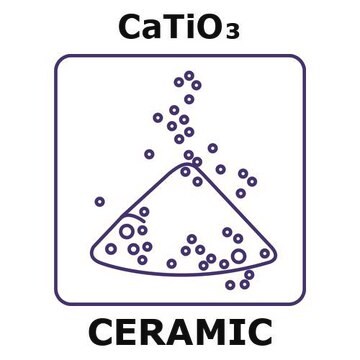633801
Calcium titanate
nanopowder, <100 nm particle size (BET), 99% trace metals basis
Synonym(s):
CALCIUM TITANIUM OXIDE
About This Item
Recommended Products
Quality Level
Assay
99% trace metals basis
form
nanopowder
surface area
5-20 m2/g
particle size
<100 nm (BET)
density
4.1 g/mL at 25 °C (lit.)
SMILES string
[Ca++].[O-][Ti]([O-])=O
InChI
1S/Ca.3O.Ti/q+2;;2*-1;
InChI key
AOWKSNWVBZGMTJ-UHFFFAOYSA-N
Looking for similar products? Visit Product Comparison Guide
Related Categories
Storage Class Code
11 - Combustible Solids
WGK
WGK 2
Flash Point(F)
Not applicable
Flash Point(C)
Not applicable
Personal Protective Equipment
Choose from one of the most recent versions:
Already Own This Product?
Find documentation for the products that you have recently purchased in the Document Library.
Customers Also Viewed
Articles
Synthesis, Properties, and Applications of Perovskite-Phase Metal Oxide Nanostructures
Perovskite-phase metal oxides exhibit a variety of interesting physical properties which include ferroelectric, dielectric, pyroelectric, and piezoelectric behavior.
Global Trade Item Number
| SKU | GTIN |
|---|---|
| 633801-25G | 4061832721866 |
| 633801-100G |
Our team of scientists has experience in all areas of research including Life Science, Material Science, Chemical Synthesis, Chromatography, Analytical and many others.
Contact Technical Service








